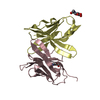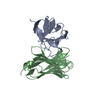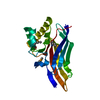+ Open data
Open data
- Basic information
Basic information
| Entry | Database: PDB / ID: 6mie | ||||||
|---|---|---|---|---|---|---|---|
| Title | Solution NMR structure of the KCNQ1 voltage-sensing domain | ||||||
 Components Components | Potassium voltage-gated channel subfamily KQT member 1 | ||||||
 Keywords Keywords |  MEMBRANE PROTEIN / MEMBRANE PROTEIN /  ion channel / ion channel /  KCNQ1 / Kv7.1 / KCNQ1 / Kv7.1 /  voltage sensor / voltage sensor /  potassium channel potassium channel | ||||||
| Function / homology |  Function and homology information Function and homology informationgastrin-induced gastric acid secretion / corticosterone secretion / voltage-gated potassium channel activity involved in atrial cardiac muscle cell action potential repolarization / basolateral part of cell / lumenal side of membrane / negative regulation of voltage-gated potassium channel activity / rhythmic behavior / regulation of gastric acid secretion / stomach development / membrane repolarization during atrial cardiac muscle cell action potential ...gastrin-induced gastric acid secretion / corticosterone secretion / voltage-gated potassium channel activity involved in atrial cardiac muscle cell action potential repolarization / basolateral part of cell / lumenal side of membrane / negative regulation of voltage-gated potassium channel activity / rhythmic behavior / regulation of gastric acid secretion / stomach development / membrane repolarization during atrial cardiac muscle cell action potential / Phase 3 - rapid repolarisation / voltage-gated potassium channel activity involved in cardiac muscle cell action potential repolarization / membrane repolarization during action potential / membrane repolarization during ventricular cardiac muscle cell action potential / regulation of atrial cardiac muscle cell membrane repolarization / iodide transport / Phase 2 - plateau phase / potassium ion export across plasma membrane / membrane repolarization during cardiac muscle cell action potential / intracellular chloride ion homeostasis / renal sodium ion absorption / negative regulation of delayed rectifier potassium channel activity / voltage-gated potassium channel activity involved in ventricular cardiac muscle cell action potential repolarization / atrial cardiac muscle cell action potential / auditory receptor cell development / detection of mechanical stimulus involved in sensory perception of sound / regulation of membrane repolarization / delayed rectifier potassium channel activity /  protein phosphatase 1 binding / positive regulation of potassium ion transmembrane transport / Voltage gated Potassium channels / outward rectifier potassium channel activity / potassium ion homeostasis / ventricular cardiac muscle cell action potential / non-motile cilium assembly / regulation of ventricular cardiac muscle cell membrane repolarization / intestinal absorption / protein phosphatase 1 binding / positive regulation of potassium ion transmembrane transport / Voltage gated Potassium channels / outward rectifier potassium channel activity / potassium ion homeostasis / ventricular cardiac muscle cell action potential / non-motile cilium assembly / regulation of ventricular cardiac muscle cell membrane repolarization / intestinal absorption /  regulation of heart contraction / monoatomic ion channel complex / ciliary base / inner ear morphogenesis / positive regulation of heart rate / cochlea development / renal absorption / adrenergic receptor signaling pathway / potassium ion import across plasma membrane / protein kinase A regulatory subunit binding / regulation of heart rate by cardiac conduction / regulation of heart contraction / monoatomic ion channel complex / ciliary base / inner ear morphogenesis / positive regulation of heart rate / cochlea development / renal absorption / adrenergic receptor signaling pathway / potassium ion import across plasma membrane / protein kinase A regulatory subunit binding / regulation of heart rate by cardiac conduction /  voltage-gated potassium channel activity / protein kinase A catalytic subunit binding / inner ear development / voltage-gated potassium channel activity / protein kinase A catalytic subunit binding / inner ear development /  social behavior / social behavior /  voltage-gated potassium channel complex / cellular response to cAMP / voltage-gated potassium channel complex / cellular response to cAMP /  transport vesicle / positive regulation of cardiac muscle contraction / potassium ion transmembrane transport / cardiac muscle contraction / cellular response to epinephrine stimulus / transport vesicle / positive regulation of cardiac muscle contraction / potassium ion transmembrane transport / cardiac muscle contraction / cellular response to epinephrine stimulus /  phosphatidylinositol-4,5-bisphosphate binding / phosphatidylinositol-4,5-bisphosphate binding /  erythrocyte differentiation / sensory perception of sound / response to insulin / cytoplasmic vesicle membrane / erythrocyte differentiation / sensory perception of sound / response to insulin / cytoplasmic vesicle membrane /  regulation of blood pressure / glucose metabolic process / cellular response to xenobiotic stimulus / late endosome / regulation of blood pressure / glucose metabolic process / cellular response to xenobiotic stimulus / late endosome /  heart development / heart development /  scaffold protein binding / basolateral plasma membrane / transmembrane transporter binding / scaffold protein binding / basolateral plasma membrane / transmembrane transporter binding /  lysosome / lysosome /  calmodulin binding / calmodulin binding /  early endosome / neuron projection / early endosome / neuron projection /  membrane raft / apical plasma membrane / neuronal cell body / membrane raft / apical plasma membrane / neuronal cell body /  endoplasmic reticulum / endoplasmic reticulum /  membrane / membrane /  plasma membrane / plasma membrane /  cytoplasm cytoplasmSimilarity search - Function | ||||||
| Biological species |   Homo sapiens (human) Homo sapiens (human) | ||||||
| Method |  SOLUTION NMR / SOLUTION NMR /  molecular dynamics molecular dynamics | ||||||
 Authors Authors | Taylor, K.C. / Kuenze, G. / Smith, J.A. / Meiler, J. / McFeeters, R.L. / Sanders, C.R. | ||||||
| Funding support |  United States, 1items United States, 1items
| ||||||
 Citation Citation |  Journal: Elife / Year: 2020 Journal: Elife / Year: 2020Title: Structure and physiological function of the human KCNQ1 channel voltage sensor intermediate state. Authors: Taylor, K.C. / Kang, P.W. / Hou, P. / Yang, N.D. / Kuenze, G. / Smith, J.A. / Shi, J. / Huang, H. / White, K.M. / Peng, D. / George, A.L. / Meiler, J. / McFeeters, R.L. / Cui, J. / Sanders, C.R. | ||||||
| History |
|
- Structure visualization
Structure visualization
| Structure viewer | Molecule:  Molmil Molmil Jmol/JSmol Jmol/JSmol |
|---|
- Downloads & links
Downloads & links
- Download
Download
| PDBx/mmCIF format |  6mie.cif.gz 6mie.cif.gz | 486.1 KB | Display |  PDBx/mmCIF format PDBx/mmCIF format |
|---|---|---|---|---|
| PDB format |  pdb6mie.ent.gz pdb6mie.ent.gz | 411.3 KB | Display |  PDB format PDB format |
| PDBx/mmJSON format |  6mie.json.gz 6mie.json.gz | Tree view |  PDBx/mmJSON format PDBx/mmJSON format | |
| Others |  Other downloads Other downloads |
-Validation report
| Arichive directory |  https://data.pdbj.org/pub/pdb/validation_reports/mi/6mie https://data.pdbj.org/pub/pdb/validation_reports/mi/6mie ftp://data.pdbj.org/pub/pdb/validation_reports/mi/6mie ftp://data.pdbj.org/pub/pdb/validation_reports/mi/6mie | HTTPS FTP |
|---|
-Related structure data
| Similar structure data | |
|---|---|
| Other databases |
|
- Links
Links
- Assembly
Assembly
| Deposited unit | 
| |||||||||
|---|---|---|---|---|---|---|---|---|---|---|
| 1 |
| |||||||||
| NMR ensembles |
|
- Components
Components
| #1: Protein | Mass: 18184.631 Da / Num. of mol.: 1 / Fragment: UNP residues 100-249 Source method: isolated from a genetically manipulated source Source: (gene. exp.)   Homo sapiens (human) / Gene: KCNQ1, KCNA8, KCNA9, KVLQT1 / Plasmid: pET16b / Production host: Homo sapiens (human) / Gene: KCNQ1, KCNA8, KCNA9, KVLQT1 / Plasmid: pET16b / Production host:   Escherichia coli (E. coli) / Strain (production host): C43(DE3) pRARE / References: UniProt: P51787 Escherichia coli (E. coli) / Strain (production host): C43(DE3) pRARE / References: UniProt: P51787 |
|---|
-Experimental details
-Experiment
| Experiment | Method:  SOLUTION NMR SOLUTION NMR | ||||||||||||||||||||||||||||||||||||||||||||||||||||||||||||||||||||||||||||||||||||||||||||||||||||||||||||||||||||||||||||||||||||||||||||||||||||||
|---|---|---|---|---|---|---|---|---|---|---|---|---|---|---|---|---|---|---|---|---|---|---|---|---|---|---|---|---|---|---|---|---|---|---|---|---|---|---|---|---|---|---|---|---|---|---|---|---|---|---|---|---|---|---|---|---|---|---|---|---|---|---|---|---|---|---|---|---|---|---|---|---|---|---|---|---|---|---|---|---|---|---|---|---|---|---|---|---|---|---|---|---|---|---|---|---|---|---|---|---|---|---|---|---|---|---|---|---|---|---|---|---|---|---|---|---|---|---|---|---|---|---|---|---|---|---|---|---|---|---|---|---|---|---|---|---|---|---|---|---|---|---|---|---|---|---|---|---|---|---|---|
| NMR experiment |
|
- Sample preparation
Sample preparation
| Details |
|
|---|
 Movie
Movie Controller
Controller













 PDBj
PDBj
